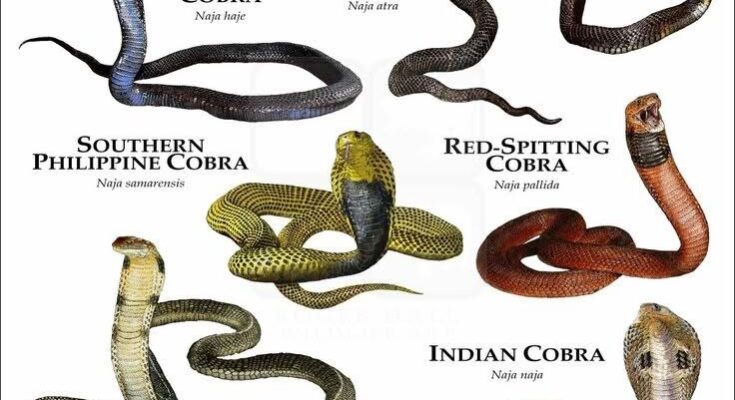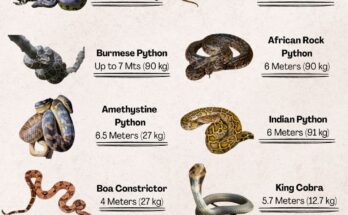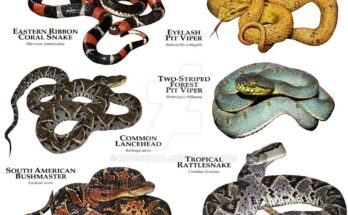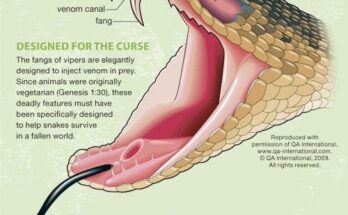Cobras of the World: A Comprehensive Guide to Iconic Species
Cobras are among the most recognizable and revered snakes in the world, known for their iconic hood displays and potent venom. This detailed guide explores six prominent cobra species—Egyptian Cobra, Chinese Cobra, Southern Philippine Cobra, Red-Spitting Cobra, Indian Cobra, and King Cobra—based on the vivid illustrations provided. Whether you’re a herpetology enthusiast, a traveler exploring cobra habitats, or simply intrigued by these majestic reptiles, this overview offers an in-depth look at their appearances, behaviors, and natural ranges as of July 05, 2025.

1. Egyptian Cobra (Naja haje)
The Egyptian Cobra, a symbol of ancient Egyptian mythology, features a striking blue-black hood that expands when threatened, revealing a lighter underbelly. Its body is typically a uniform dark brown or black, growing to lengths of 4-6 feet, though some can reach 8 feet. Native to North Africa and the Middle East, this venomous snake inhabits deserts, savannas, and agricultural areas. Known for its neurotoxic and cytotoxic venom, it preys on rodents, birds, and other snakes, using its hood to intimidate predators. Its historical significance as a protector and a threat underscores its cultural importance.
2. Chinese Cobra (Naja atra)
The Chinese Cobra, prevalent in southern China and parts of Southeast Asia, boasts a sleek, dark brown to black body with a hood that displays a distinctive spectacle-like pattern when spread. Adults typically measure 4-5 feet, with some exceeding 6 feet. This species thrives in forests, fields, and suburban areas, feeding on amphibians, small mammals, and birds. Its venom, a mix of neurotoxins and hemotoxins, can cause severe pain and respiratory failure. The Chinese Cobra is also known for its defensive spitting ability, aiming venom at the eyes of threats, making it a formidable presence.
3. Southern Philippine Cobra (Naja samarensis)
The Southern Philippine Cobra, found in the Philippines, is characterized by its vibrant yellow-green hood with dark banding, contrasting with its darker body. Growing to 3-5 feet, this agile snake inhabits lowland forests and agricultural lands. Its venom is highly neurotoxic, capable of causing paralysis and death if untreated. This species is an adept climber and swimmer, preying on rodents and other snakes. Its striking coloration serves as a warning, and it often raises its hood to deter predators in its island habitats.
4. Red-Spitting Cobra (Naja pallida)
The Red-Spitting Cobra, native to East Africa, stands out with its reddish-brown to orange hue, which intensifies when it flares its hood. Adults range from 3-4 feet, with some reaching 5 feet. This cobra is renowned for its ability to spit venom accurately up to 6-8 feet, targeting the eyes to cause blindness or intense pain. It inhabits arid regions, savannas, and rocky areas, feeding on small vertebrates. Its venom, a potent neurotoxin, requires immediate medical attention, highlighting its dangerous reputation.
5. Indian Cobra (Naja naja)
The Indian Cobra, widespread across the Indian subcontinent, features a gray or brown body with a hood adorned with a spectacled or monocled pattern. Adults typically grow to 4-6 feet, with some exceeding 7 feet. A cultural icon in India, often associated with snake charmers, it thrives in a variety of habitats, including forests, fields, and villages. Its neurotoxic venom can be lethal, targeting the nervous system. This cobra preys on rodents, birds, and reptiles, using its hood display to ward off threats, making it a symbol of both danger and fascination.
6. King Cobra (Ophiophagus hannah)
The King Cobra, the world’s longest venomous snake, commands respect with its olive-green to black body, often with faint banding, and a wide hood. Capable of reaching 10-18 feet, it dwarfs other cobras. Found in Southeast Asia, including India, Thailand, and the Philippines, it inhabits forests and swamps, preying primarily on other snakes, including its own kind. Its venom, a powerful neurotoxin, can kill an elephant with a sufficient dose, though it avoids humans unless provoked. The King Cobra’s deep hiss and impressive size make it a formidable apex predator.
Exploring the World of Cobras
These six cobra species showcase the diversity within the Naja and Ophiophagus genera, each adapted to its unique environment. From the arid deserts of Egypt to the lush forests of Southeast Asia, cobras play a critical role in controlling pest populations and maintaining ecological balance. The image above provides a visual guide to their distinct hood patterns and coloration, aiding identification. While their venomous nature demands caution—always maintain a safe distance and seek medical help if bitten—their beauty and behavior offer a window into the wild’s complexity. As of today, conservation efforts continue to protect these species from habitat loss and human conflict.
Note: For safety and further details, consult local wildlife experts or resources when exploring cobra habitats.



